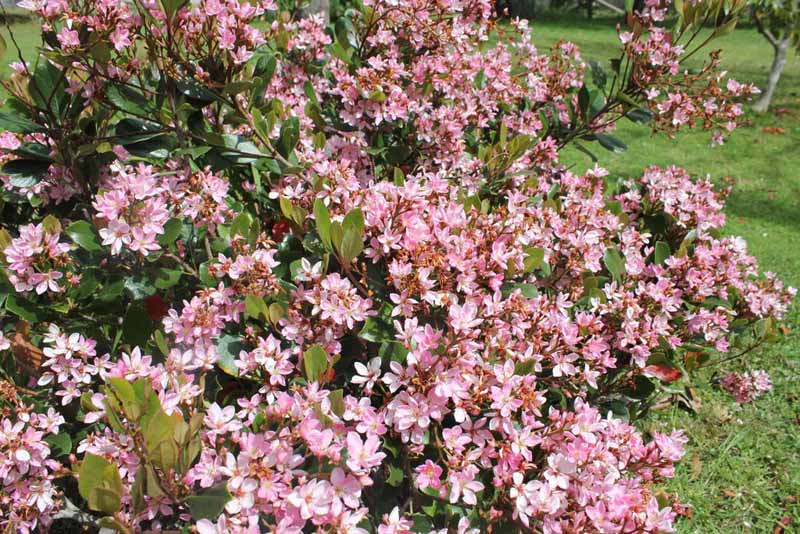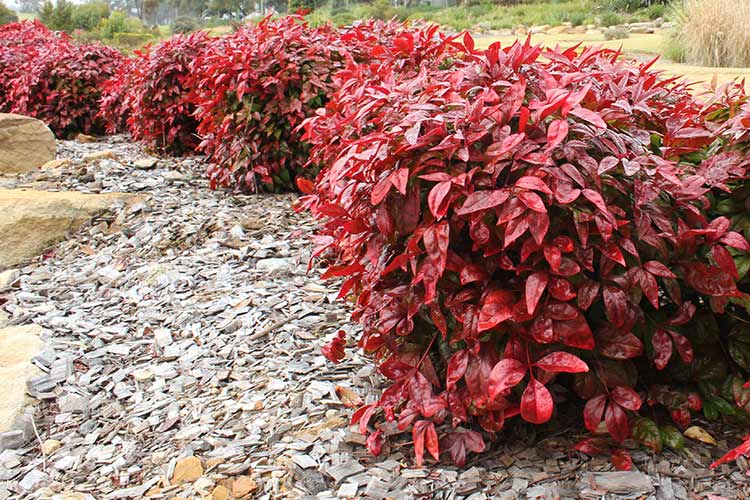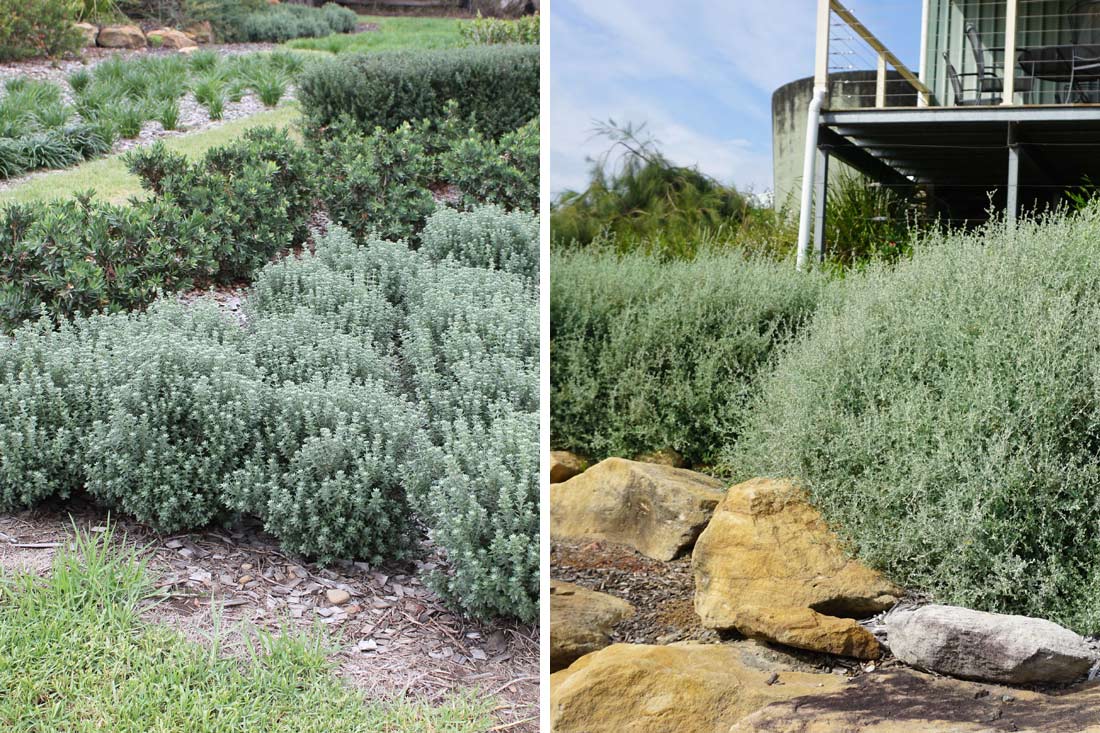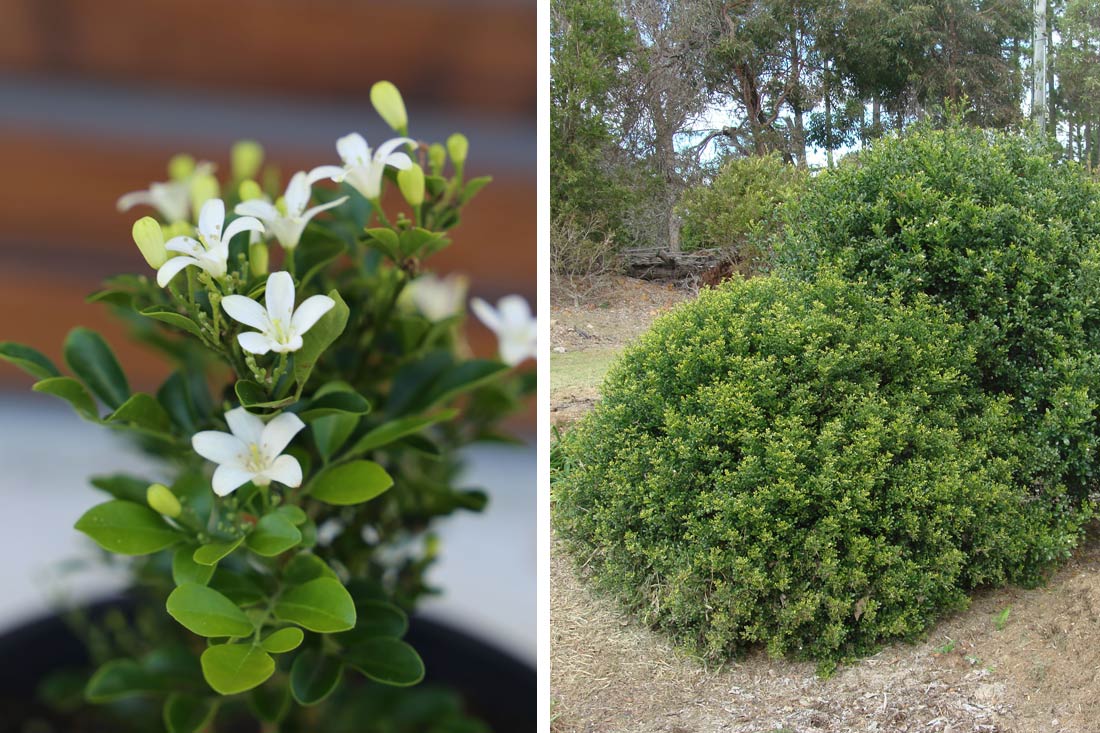Natives are great, but that doesn’t mean exotic hedges and screens don’t also have their place. Whether you’re looking for privacy, beauty or biodiversity, there’s an exotic hedge perfect for your needs.
This article will provide you with a list of the most resilient and low-maintenance exotic hedges that are available in Australia.
Hardy Exotic Hedges and Screens
Photinia
Photinia is a favourite among garden enthusiasts around the world for its vibrant red new growth, which gradually matures into a glossy green. This transition creates a dynamic visual interest throughout the year, making it an ideal choice for those seeking a hedge that provides some transition across seasons. Its dense foliage ensures effective screening, providing privacy and bountiful flowers for pollinators.

Thin Red™ Photinia x fraseri ‘NP01’ PBR. https://www.ozbreed.com.au/plant-ranges/hardy-exotic-range/thin-red/
Viburnum
Known for its lush, dense foliage and fragrant flowers, Viburnum species create a green sanctuary that not only screens but also supports local wildlife. Their ability to thrive in various conditions makes them a versatile choice for many garden settings. These plants tend to be fast-growing, meaning they get to size quickly but require constant pruning to keep in shape.

Quick Fence™ Viburnum odoratissimum ‘VOQ1’ PBR Intended. https://www.ozbreed.com.au/plant-ranges/hardy-exotic-range/quick-fence/

Dense Fence™ Viburnum odoratissimum ‘VOC1’ PBR. https://www.ozbreed.com.au/plant-ranges/hardy-exotic-range/dense-fence-viburnum/
Rhaphiolepis
Rhaphiolepis has a dense, compact growth habit and attractive blooms. This makes it perfect for creating robust privacy barriers that are both effective and charming. Its slower-growing nature and tolerance to various conditions make Rhaphiolepis a practical yet beautiful addition to any low-maintenance garden.
Cosmic White™ Rhaphiolepis indica ‘RAPH01’ PBR. https://www.ozbreed.com.au/plant-ranges/hardy-exotic-range/cosmic-white-rhaphiolepis/

Cosmic Pink™ Rhaphiolepis indica ‘RAPH02’ PBR. https://www.ozbreed.com.au/plant-ranges/hardy-exotic-range/cosmic-pink-rhaphiolepis/
Rhododendron (Azaleas)
Azaleas, a popular variety of Rhododendron, are celebrated for their stunning floral displays. These lush blooms, available in a wide range of hues, bring a burst of colour to garden borders and beds. Azaleas’ ability to flourish in various light conditions makes them a versatile choice, providing both visual interest and a fragrant screening solution that captivates and delights. Avoid pruning buds as doing so stunts the floral display.

Encore Azaleas. https://www.ozbreed.com.au/encore-azaleas/
Loropetalum
Loropetalum is admired for its striking foliage and vibrant pink flowers. This evergreen shrub offers an eye-catching contrast with its rich, dark leaves and bright blooms, making it a standout feature in any garden design. Its dense growth habit provides effective screening of small objects like HVAC units, while its low-maintenance nature ensures that beauty is accompanied by practicality.

Purple Pixie™ Loropetalum chinense ‘PEACK’ PBR. https://www.ozbreed.com.au/plant-ranges/hardy-exotic-range/purple-pixie-loropetalum-is-a-groundcover-plant-with-rich-purple-foliage-hardy-exotic-range/
Gardenia
Gardenia is synonymous with romance in the garden, thanks to its fragrant, creamy white flowers and glossy green leaves. This plant is perfect for adding a touch of elegance and sophistication to garden spaces. Gardenia’s ability to thrive in various conditions and its lovely scent make it an ideal choice for creating intimate, fragrant havens within larger landscape designs.

O So Fine™ Gardenia augusta ‘KEN04’ PBR. https://www.ozbreed.com.au/plant-ranges/hardy-exotic-range/o-so-fine-gardenia-is-a-finer-leaf-groundcover-plant-with-masses-of-white-flowers-hardy-exotic-range/
Metrosideros
Metrosideros, known for its vibrant red blooms, is a spectacular choice for gardeners aiming to attract birds and insects. Metrosideros adds a bold splash of colour.

Velvet Sky™ Metrosideros collina ‘MB01’ PBR. https://www.ozbreed.com.au/plant-ranges/hardy-exotic-range/velvet-sky-metrosideros/
Nandina
Often referred to as heavenly bamboo, Nandina brings a delicate touch with its fine foliage and rich autumn colours. Throughout the seasons, it changes colour from orange/red to green, to purple, making it a preferred choice for gardeners looking to introduce colour variation and subtlety into their landscapes.
Obsession™ Nandina domestica ‘SEIKA’ PBR. https://www.ozbreed.com.au/plant-ranges/hardy-exotic-range/obsession-nandina-is-an-exotic-plant-with-bright-red-new-growth-for-most-of-the-year-hardy-exotic-range/
Flirt™ Nandina domestica ‘MURASAKI’ PBR. https://www.ozbreed.com.au/plant-ranges/hardy-exotic-range/flirt-nandina/

Blush™ Nandina domestica ‘AKA’ PBR. https://www.ozbreed.com.au/plant-ranges/hardy-exotic-range/blush-nandina/
Murraya
Murraya, with its lush foliage and jasmine-scented blossoms, offers an exotic flair that is hard to resist. Its ability to form dense hedges makes it an excellent choice for those looking to introduce both structure and fragrance into their gardens. Murraya’s resilience and beauty ensure it remains a staple in Australian garden design.
Sweet Privacy™ Murraya paniculata ‘MP01’ PBR. https://www.ozbreed.com.au/plant-ranges/hardy-exotic-range/sweet-privacy/
Exotic Plants With Ecological Value
There’s a myth floating around amongst social media influencers and Tik Tok activists that says native plants are the only option for supporting the local ecology. If that were true, why are so many of them so attractive to so many native insects?
Whether it’s a lavendar, a parsley, or a murraya, we’ve all seen exotic plants attracting a wide range of different types of insects, whether they’re providing a food source or simply habitat. Our native Australian pollinators and other fauna are, for the most part, just as happy to find shelter in and feed on exotic foliage, flowers, fruits and seeds as they are feeding on native resources.
Now, there are specialist plant-animal relationships that need help, and you should absolutely research the individual species that can make a big difference. However, simply saying “plant natives” or “plant exotics” is too simplistic to be useful in the real world.
Instead, we should think like nature, do the least harm, and provide abundant resources for ecology. At the end of the day, urban conditions are nothing like those found in a natural resource management setting, and we can never recreate a natural setting when we have roads, houses, altered soils, mowers, and different ecological communities.
Don’t let anyone tell you planting exotic plants is bad for the environment, because it’s simply not true. Exotic plants are a huge part of urban ecology.
Conclusion
If you’re going to go to all the effort of planting a hedge or screen, you want it to perform well. Whether you’re looking for fast-growing plant that you’ll need to hedge all the time, or a slow-growing hedge that will take a little longer to get to size but will need less pruning, there’s a perfect variety to suit your needs.
It might be worth avoiding fussy exotic hedging and screening plants that need a lot of attention, and instead opt for a plant from this list which is a lot hardier and more resilient.





